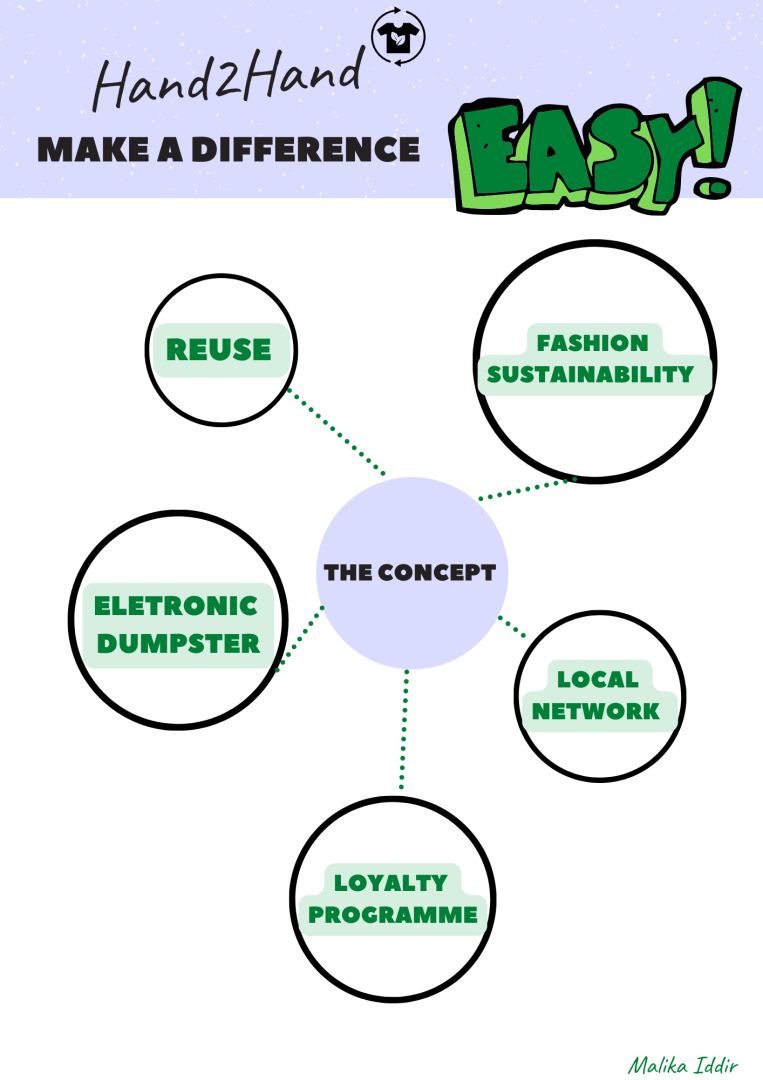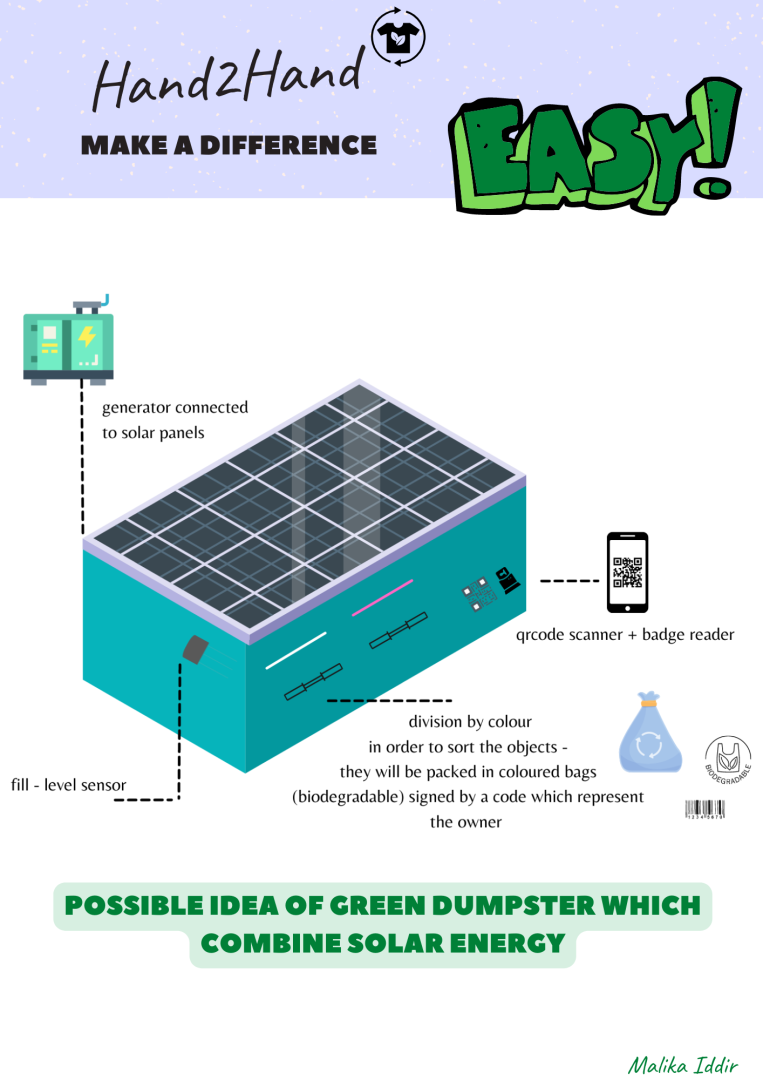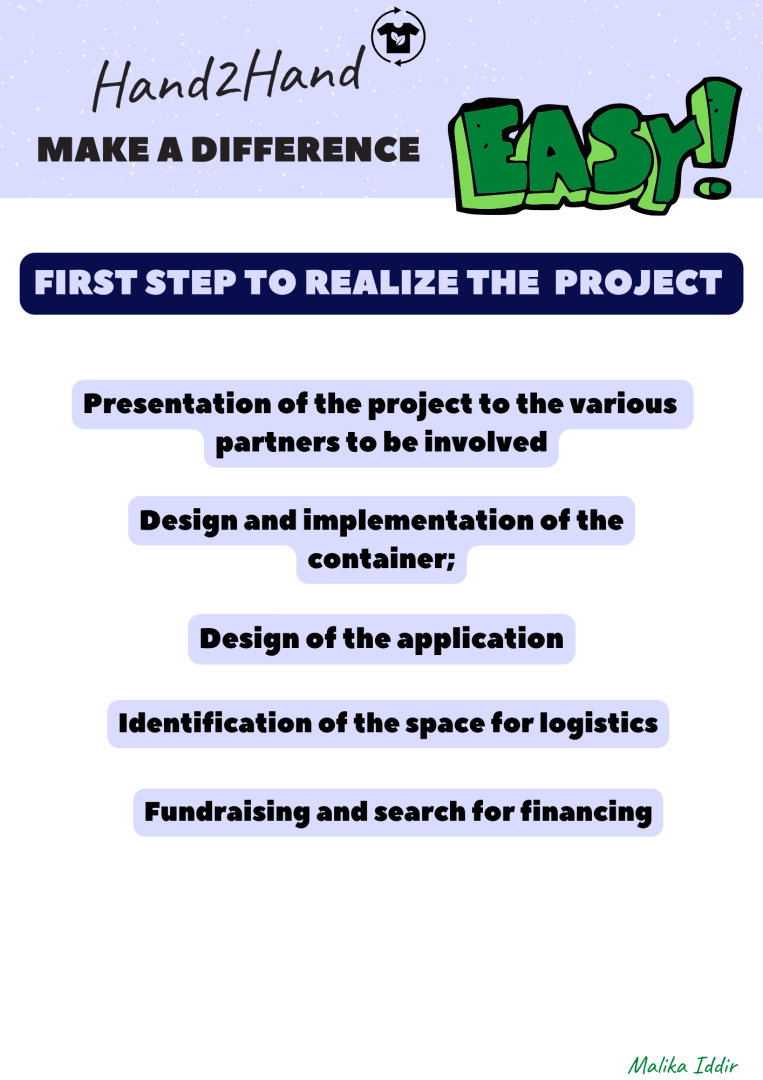hand to hand
Basic information
Project Title
Full project title
Category
Project Description
Organise the disposal process of Second Hand clothes through an app linked to "Green Boxes":
- choose the clothes you don't use,
- describe them briefly (form),
- prepare the packages,
- leave them in the "green box" for collection,
- earn points and receive discount vouchers by donating clothes, taking Second Hand quizzes, keeping track of the "life" of your wardrobe (consumer awareness). Collected clothes are given to Second Hand shops which participate to the programme.
Geographical Scope
Project Region
Urban or rural issues
Physical or other transformations
EU Programme or fund
Which funds
Description of the project
Summary
The idea I am proposing is the concept of a circular economy system that follows the life of textile products: in fact, the aim is to improve the efficiency of garment disposal. Inspired by the bins that are used to collect clothing donations, I thought of developing a more modern and technological concept of a bin which can
- recognize who is donating through a card system or QR code connected to the app that everyone has to download in order to be part of the programme. This part is very important to ensure the tracking of clothes
- system of control: the dumpster can recognize when it's full of packagings, this avoids unnecessary travel to empty it
- app: realisation of a loyalty programme that will allow the user to donate their clothes, to learn and be aware of the issue of sustainable fashion and to receive in return discount vouchers to spend in shops promoting the programme, free tickets for cultural events and gifts according to a criteria
Donating clothes will be easier than ever: in fact the person who wants to give away his clothes has to:
- download the app,
- enter the information about the products he will donate
- packing all them in biodegradable bags that will be provided to him free of charge once he joins the programme.
- bring packages to the dumpster
The bags will have a specific code to identify the user. The dumpster will open only using the card (also charged once joint the programme) or the QR code inside the app in order to avoid people who mistake the dumpster for a rubbish bin, throwing everything into it.
The last aspect concerns the sorting of the products: once the products are divided by category (well-kept, to be repaired and to be recycled), they will be fed into the various channels created through the local network. There are businesses that sell second-hand products that will be supplied by this system, while others deal with sustainable disposal.
Key objectives for sustainability
The project presented here has an important environmental impact precisely because it aims to manage a slice of waste that is often untraceable: textiles. On the one hand, it aims to encourage individuals to become aware of what is behind a garment: it is easy to buy it, but more difficult to dispose of it. In recent years, various strategies have been adopted to avoid waste, but they are not well coordinated and do not take into account the environmental impact: first of all transport, then one other aspect is related to waste disposal (creation of mountains of clothes for example). On the contrary, the hand2hand project wants to try to use new technologies in a more efficient system including
- Reducing waste: each garment collected has its own destination, in fact the purpose is to follow the life cycle of the clothes;
- Exploiting a local network system that tries to avoid unnecessary use of transport and put together different realities which can work to create an efficient system;
Key objectives for aesthetics and quality
The aesthetic aspect and the quality of the experience are linked above all to the method chosen for waste management: first of all, on an aesthetic level, the dumpsters will be customisable, trying to involve citizens in this. In that way, the design that will decorate the container can be chosen and approved by those who use it.It is necessary to see it as a space, rather than a simple object in which to throw or discard clothes. Quality, on the other hand, will refer to the experience of recycling own used clothes: from home used clothes will be selected and registered in the application connected to the dumpster. It is necessary to see it as a space, rather than a simple object in which to throw discard clothes. Quality, on the other hand, will refer to the experience of recycling one's own used clothes: used clothes are selected from home and registered in the application connected to the dumpsters. The user will put them in biodegradable bags which will be provided: the bags will have a code printed according to the user, this to ensure the traceability of the products (any reports etc. will be easier to do). Once the bags are ready, they must be thrown into the bin after accessing it by card or scanning the qrcode (the bin thus ensures that no random items, useless rubbish etc. are thrown in).
Key objectives for inclusion
The idea I am proposing has many aspects that make it inclusive: in fact, there is the idea that the dumpster should not be anonymous but should be decorated so that it can be seen with a different conception, that it is not a waste container. This means that different designs can be shared by the citizens and approved by them, so that in each city the bin takes on the colours and ideas of the people who live there.
Inclusiveness will then take on different forms precisely because the loyalty programme is designed to teach even those who do not have the tools, what sustainable fashion means, what waste means, what impact critical consumption of clothing has on the environment, as well as the ability to better understand fabrics and therefore the clothes we use every day. You cannot think of changing habits without educating people to do so, even in the simplest ways (e.g. quizzes on an app with videos and free-access documents that do not misinform). The loyalty programme will also guarantee the possibility of earning tickets for cultural events to make culture even more accessible (e.g. shows, museums, etc.).
Inclusiveness is not only present for those who will benefit from the implemented programme, but also for those who will participate in the process of realising the idea: protected categories who often find it hardest to be included in the work will be involved in the project. This is a way of guaranteeing access to an opportunity that is good for the environment but also for people.
Physical or other transformations
Innovative character
The three dimensions in the project will be combined in the system created as they are closely linked to the basis of the design. As explained above, the aspect of environmental sustainability is linked to the purpose of the project itself: that is, the management of the garments from their return for sale as a supply for the second-hand market to their actual disposal, which is not intended to harm the environment, but to be designed to ensure the proper reuse of the fabrics where possible. The aesthetic and qualitative dimension of the experience is linked to the fluid and functional process that will be created with this system: from the electronic bin connected to a user-friendly application, to the personalisation of the bin itself which will make it a beautiful object and above all shared by the citizens. Moreover, the way in which the clothes have to be donated is also accurate and makes the experience more pleasant: it is not throwing away the clothes, but putting them away as a real gift. Attention to the care of how to treat the products is important to give a sense of importance to what you are going to do.
Inclusivity will be present both in the process of participation in the loyalty programme created, which aims to make people more aware, even those who do not have the tools to do so, and is easy to access, even for those who do not have direct access to the internet every day: it will be enough to sign up to the programme (by telephone for example or through an access point located in the shops participating in the programme) and you will receive at home the card to use the bin as well as the material for packing. Inclusiveness will also be part of the implementation process, as local social organisations and people from protected categories will be involved.




